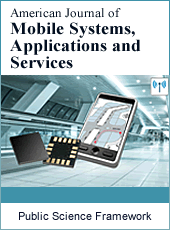American Journal of Mobile Systems, Applications and Services
Articles Information
American Journal of Mobile Systems, Applications and Services, Vol.1, No.1, Aug. 2015, Pub. Date: Jul. 23, 2015
Modeling Land Mobile Satellite Channel and Mitigation of Signal Fading
Pages: 46-53 Views: 5224 Downloads: 1499
[01]
Oluyomi Aboderin, Department of Engineering and Space Systems, National Space Research and Development Agency (NASRDA), Abuja, Nigeria.
[02]
Isiaka A. Alimi, Department of Electrical and Electronics Engineering, School of Engineering and Engineering Technology, Federal University of Technology, Akure, Nigeria.
Land mobile satellite (LMS) is an important aspect of satellite communication to everyone across the globe due to the services available through it. To this effect, modeling the channel in this services is also very important, so as to ensure availability, quality of service (QoS), and reduce outages on the channel, which in turn will results into value for money, safety of lives and properties, and even reduce cost both from the operator’s point of view and user’s point of view. In this work, a Lutz two-state statistical model was used to model the behavior of a complete channel in two different transmission environments namely: shadowing and un-shadowing or line-of-sight (LOS) and non-line-sight (NLOS) conditions. However due to the influence of the propagation environment on the LMS signals, there were outages (fading) along the 200meters length of the measurement campaign. To reduce these outages, satellite diversity technique was employed. This technique pair together two satellites having the same masking angle and both simultaneously linked with the mobile terminal. The results show that connectivity to the two satellites improved the satellites availability to the mobile terminal up to 90%, and the service quality also was improved.
Land Mobile Satellite (LMS), Channel, Lutz Two-State Statistical Model, Shadowing, Unshadowing, Line-of-Sight (LOS), Non-Line-of-Sight (NLOS), Mobile Terminal
[01]
R. E. Sheriff and Y. F. Hu, Mobile Satellite Communication Networks, First Edition ed. Chichester: John Wiley & Sons, Ltd., 2001.
[02]
W. J. Vogel, "Satellite Diversity for Personal Satellite Communications - Modelling and Measurements," presented at the 10th International Conference on Antennas and Propagation, London, 1997.
[03]
M. Rieche, A. Ihlow, D. Arndt, F. Perez-Fontan, and G. Del Galdo, "Modeling of the Land Mobile Satellite Channel considering the Terminal's Driving Direction," International Journal of Antennas and Propagation, 2015 2015.
[04]
F. P. Fontan and P. M. Espineira, Modeling the Wireless Propagation Channel A Simulation Approach with MATLAB, 229 ed. Chichester: Wiley and Sons Ltd, 2008.
[05]
S. R. Saunders and A. A. Zavala, Antennas and propagation for Wireless Communication Systems, Second Edition ed. Chichester: John Wiley & Sons Ltd., 2007.
[06]
L. J. Ippolito, Satellite Communications Systems Engineering: Atmospheric Effects, Satellite Link Design and System Performance. Chichester: John Wiley & Sons Ltd, 2008.
[07]
E. Lutz, "A Markov model for correlated land mobile satellite channels," International Journal of Satellite Communications, vol. 14, pp. 333-339, 1996.
[08]
E. Lutz, M. Werner, and A. Jahn, Satellite Systems for Personal and Broadband Communications, 1st ed. Berlin: Springer, 2000.
[09]
H. Bischl, M. Werner, and E. Lutz, "Elevation-dependent channel model and satellite diversity for NGSO S-PCNs," 1996 Ieee 46th Vehicular Technology Conference, Proceedings, Vols 1-3, pp. 1038-1042, 1996.
[10]
S. Scalise, H. Ernst, and G. Harles, "Measurement and Modelling of the Land Mobile Satellite Channel at Ku band," IEEE Transaction on Vehicular technology, vol. 57, p. 11, 2008.
[11]
E. Lutz and Ieee, "Modelling of the Satellite Communications Channel - With Emphasis on the Land Mobile Satellite Channel," 2012 Ieee First Aess European Conference on Satellite Telecommunications (Estel), 2012 2012.
[12]
M. Z. H. Bhuiyan, J. Zhang, E. S. Lohan, W. Wang, and S. Sand, "Analysis of Multipath Mitigation Techniques with Land Mobile Satellite Channel Model," Radioengineering, vol. 21, Dec 2012.
[13]
M. Cheffena, F. Perez Fontan, F. Lacoste, E. Corbel, H.-J. Mametsa, and G. Carrie, "Land Mobile Satellite Dual Polarized MIMO Channel Along Roadside Trees: Modeling and Performance Evaluation," Ieee Transactions on Antennas and Propagation, vol. 60, pp. 597-605, Feb 2012.
[14]
E. Lutz, "Issues in satellite personal communication systems," Wireless Networks, vol. 4, pp. 109-124, 1998.
[15]
M. C. Jeruchim, P. Balaban, and S. K.S, Simulation of Communication Systems Modelling, Methodology and Techniques, Second Edition ed. New York, 2000.
[16]
F. P. Fontan, S. Martinez, B. Sanmartin, C. Enjamio, P. Marino, and F. Machado, "An enhanced Markov chain based model for the narrowband LMS channel in built-up areas," International Journal of Satellite Communications and Networking, vol. 23, pp. 111-128, 2005.
[17]
E. Lutz, D. Cygan, M. Dippold, F. Dolainsky, and W. Papke, "The land mobile satellite communication channel-recording, statistics, and channel model," Ieee Transactions on Vehicular Technology, vol. 40, pp. 375-386, 1991

ISSN Print: 2471-7282
ISSN Online: 2471-7290
Current Issue:
Vol. 5, Issue 1, March Submit a Manuscript Join Editorial Board Join Reviewer Team
ISSN Online: 2471-7290
Current Issue:
Vol. 5, Issue 1, March Submit a Manuscript Join Editorial Board Join Reviewer Team
| About This Journal |
| All Issues |
| Open Access |
| Indexing |
| Payment Information |
| Author Guidelines |
| Review Process |
| Publication Ethics |
| Editorial Board |
| Peer Reviewers |


